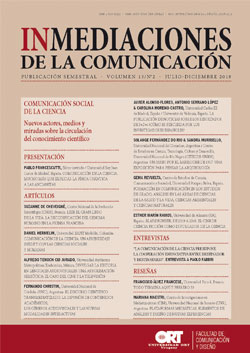Leia o grande livro da vida. A decodificação do genoma humano na imprensa francesa
DOI:
https://doi.org/10.18861/ic.2018.13.2.2866Palavras-chave:
genoma humano, decodificación, biotecnología, periódicos franceses.Resumo
On 26 June 2000, in a spectacular press conference, the Human Genome Project, an international public consortium, and Celera Genomics, a private company founded in 1998 by the genetician Craig Venter jointly announced the nearly complete decoding of the human genome. The following year, in February 2001, the announcement was reiterated when the the results were published in the scientific journals Science and Nature. All the main media reported and commented these events.This article makes a comparative analysis of articles published in the most importantFrench daily newspapers (La Croix, Le Figaro, L’Humanité, Libération, Le Monde and Le Parisien) on the announcementsrelated to the human genome project. The metaphors mobilised around the project, the graphics, the scientific explanations as well as the analysis of the discovery’s implicationsare the focus of the analysis. Just a few newspapersrecalled that humans are not exclusively inscribed in their genes and that they are as marked by their history and their environment as by their genetic code. The old quarrel between the nature and nurture arises again: do 30000 genes really make a human being? The very meaning of DNA, the material support of a part that is transmited by each generation, differ according the newspaper and every reader. The vision of researchers and the trust they must givethe importance of the intellectual adventure or the perspectives of applications or potential risks, there are a relevant part and parcel of the different representations of the “progress” of science.
The news coverage of the announcements about the Human Genome Project shows different visions about the decoding of the philosophies related to the human being. Popular newspapers are preoccupied by eugenic perspectives. Papers with strong moral references (whether L’Humanité, La Croix or Le Figaro) energetically recall the role of history and environment in the genesis of man. Others, but in particular Libération, were more inclined to see humans inscribed in their genes. In summary, we have found a large diversity among the press’s discourse, also expressing different point of views of science.In this sense, the research shows that popular newspapers have systematically taken a certain distance from the scientific world, remarking the ethical questions often raised by their work. The so called elite newspapers have shown themselves to be closer to the political and scientific institutions, quicker in showing trust in researchers, though with some nuances. All these media discourse carry traces of a society’s questions and hesitations when faced with the evolutions of life sciences that probe and shift the boundaries of humanity.
Downloads
Referências
Berlan, J. P. (26 de junio de 2000). Qu’est-ce qu’un gène humain? Débats, Le Monde.
Cheveigné, S. (2000). L’Environnement dans le journal télévisé. Médiateurs et visions du monde. Paris, France: CNRS Éditions.
Cheveigné, S. & Verón, E. (1994). The Nobel on First Page: The Nobel Physics Prizes in French Newspapers. Public Understanding of Science, 3, 135-154
Cheveigné, S., Boy, D. & Galloux, J. C. (2002). Les Biotechnologies en débat. Paris, France: Balland.
Debré, B. (27 de junio de 2000). L’homme n’est pas un code-barres. France Soir.
Doumlring, M. (2005). A sequence of “factishes”: the media-metaphorical knowledge dynamics structuring the German press coverage of the human genome. New Genetics and Society, 24(3), 317-336.
Gogorosi, E. (2005). Untying the Gordian knot of creation: metaphors for the Human Genome Project in Greek newspapers. New Genetics and Society 24(3), 299-315.
Habermas, J. (1978). L’Espace public. Paris, France: Payot.
Hellsten, I. (2005). From sequencing to annotating: extending the metaphor of the book of life from genetics to genomics. New Genetics & Society 24(3), 283-297.
Holtzman, N. A., Bernhardt, B. A., Mountcastle-Shah, E., Rodgers, J., Tambor, E. & Geller, G. (2005). The Quality of Media Reports on Discoveries Related to Human Genetic Diseases. Community Genetics, 8, 133-144.
Lewontin, R. C. (1991). Biology as Ideology: The Doctrine of DNA. New York, US: Harper Collins.
Nelkin, D. & Lindee, S. (1996). The DNA Mystique: The Gene as a Cultural Icon. Ann Arbor. Michigan, US: University of Michigan Press.
O’Mahony, P. & Schäfer, M. S. (2005). The “Book of Life” in the Press. Comparing German and Irish Media Discourse on Human Genome Research. Social Studies of Science, 35(1), 99-130.
Verón, E. (1988). Presse écrite et théorie des discours sociaux: production, réception, regulation. In P. Charaudeau (ed.), La Presse: produit, production, reception (pp. 11-25). Paris, France: Didier.





